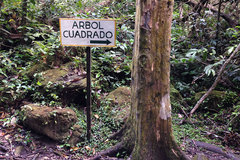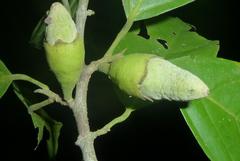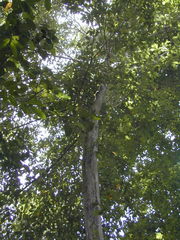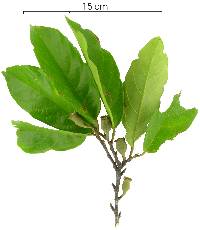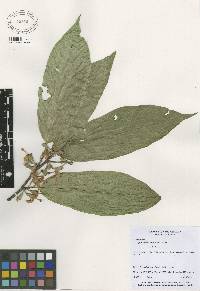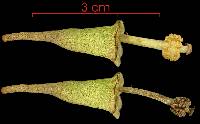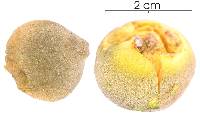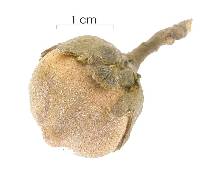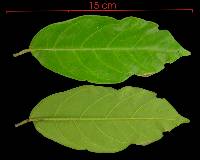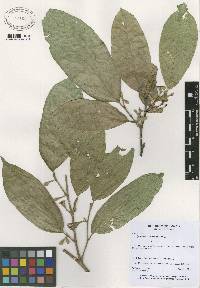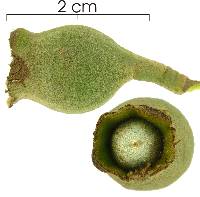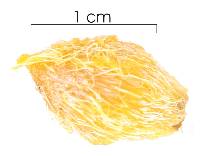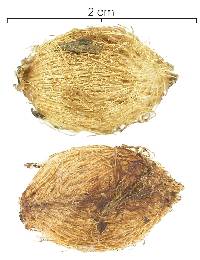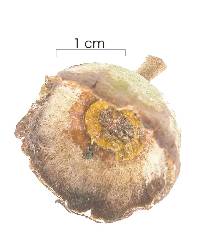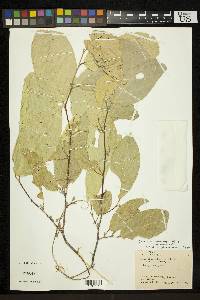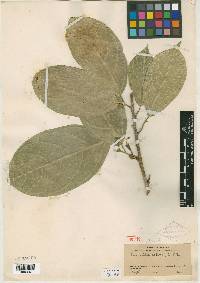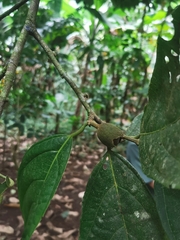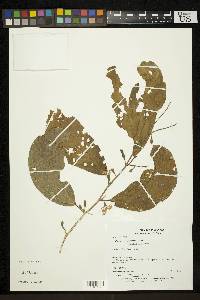

|
|
|
|
Family: Bombacaceae
cinco dedos, more...guayabillo
|
Description: Tall forest tree with very straight trunk, branches only near the top. The trunk has an unusual form, not cylindrical, but rather flanged, sometimes nearly square in cross-section. At the base, the the flanges usually spread to form narrow, but tall buttresses. The bark peels off readily, leaving a very smooth, naked, light gray trunk, with irregular vertical greenish or dark gray bands. Branches emerge perpendicular to trunk, four from one spot (verticillate branching); each set of horizontal branches can form a distinct layer, separate from the next layer up. Leaves are alternate, oval, with three major veins emerging together from base. Leaf stalk swollen at both ends and scaly. Reproduction: Produces yellowish-white flowers during the early part of the wet season; these fall abundantly on the ground below large trees. Fruits are large, eaten by many larger birds and mammals. Distribution: One of the dominant canopy trees in the Barro Colorado old-growth, otherwise only found occasionally in the forest at Pipeline Rd. and the Fort Sherman area. Never seen in farmland or residential areas. Similar Species: Medium-sized and large trees are readily recognized by the peculiar, smooth, flanged trunk. LK guapst Guapira standleyanum LK2 on Barro Colorado has a ribbed trunk of the same size and shape as large Q. asterolepis, but it has brown bark, not like the smooth naked trunk of Quararibea. Small Q. asterolepis can easily be confused. LK quarpt Quararibea pterocalyx LK2 has similar leaves, lighter in color on the underside, and does not reach such a large size. Easy to confuse are species of Theobroma. One species known only from wet areas at Sherman and Santa Rita, LK theobe T. bernoulli, LK2 has leaves quite like Q. asterolepis, but is just a small treelet. There are other Theobroma species, but only in upland areas and on the Santa Rita ridge. Descripción: Árbol de 10 a 25 m de alto. Tronco con ramificación verticilada. Hojas simples y alternas, de 10-28 x 3-12 cm, elípticas, lanceoladas a oblongas, con ápice acuminado, bordes enteros y base decurrente. Las hojas son pubescentes por el envés. Estípulas persistentes o deciduas. Pecíolo de 0.5-1 cm de largo, delgado en la base e hinchado en el ápice. Flores blancas, usualmente opuestas a las hojas. Frutos ovoides a globosos, de 1.5-2 cm de largo, envueltos en la base por los restos del cáliz, verdes, tornándose amarillos cuando maduros. Datos Ecológicos: La especie crece a bajas y medianas elevaciones, en bosques húmedos o muy húmedos. En Panamá se encuentra en las provincias de Colón, Darién y la comarca de Guna Yala. Florece y fructifica de marzo a octubre. Especies Parecidas: En la isla de Barro Colorado Quararibea stenophylla fue erróneamente identificada como Quararibea asterolepis. Usos: No se conocen usos para la especie. Bocas Species Database Characteristics: Tree |
|
|
|


